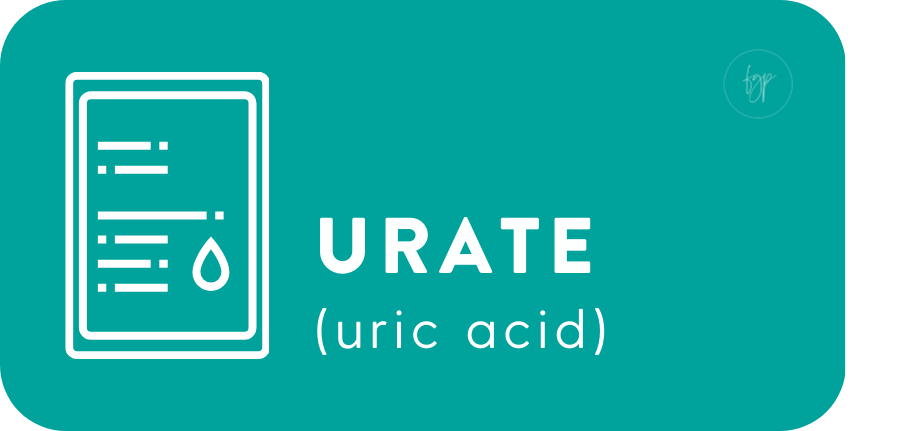What is going on?
Your lab tests

Urate (uric acid)
Reflects the balance between production and excretion of uric acid, a waste product from purine metabolism.
Your result is raised
When Levels are High
Most commonly metabolic, particularly in women during perimenopause and menopause. Also increased by diets high in purines (red meat, seafood), alcohol, reduced kidney excretion (renal impairment), gout, metabolic syndrome, medications (e.g., diuretics), and increased cell turnover (chemotherapy, leukemia).
Your result is low
When Levels are Low
Less common; associated with liver disease, excessive kidney excretion, certain medications, or rare genetic disorders (Fanconi syndrome).
WE’RE HERE TO HELP YOU
Understanding trends in the results
Rising levels indicate higher risk of gout, kidney stones, and metabolic disorders. Persistent low levels are rare but may signal underlying kidney or liver conditions.
A deeper dive
Uric acid is a marker of inflammation and oxidative stress. Levels rise during inflammation as damaged cells release purines, increasing uric acid production. Elevated urate is strongly associated with cardiovascular disease (CVD), metabolic syndrome, and insulin resistance, making it a valuable predictive marker for these conditions. In gout, crystallized uric acid accumulates in joints, causing severe pain and inflammation; medications (e.g., allopurinol, febuxostat) effectively reduce uric acid production and prevent gout attacks. Maintaining optimal levels through medication, diet, and lifestyle interventions helps manage inflammation, reduces gout risk, and potentially lowers cardiovascular risks.
Purines are natural chemical compounds found in cells of plants, animals, and humans. They are essential building blocks for DNA and RNA (genetic material) and play roles in energy metabolism.
When your body breaks down purines, it produces uric acid as a waste product. Normally, uric acid dissolves in the blood, is filtered through the kidneys, and eliminated in urine.
Foods high in purines include:
- Red meat (beef, lamb)
- Organ meats (liver, kidneys)
- Seafood (anchovies, sardines, mussels, scallops)
- Certain legumes and beans
- Alcohol (especially beer)
Why purines matter for urate:
A diet rich in purines can increase uric acid production. In conditions like gout or metabolic syndrome, excess uric acid can accumulate, forming crystals in joints and tissues, causing inflammation and pain.
Managing purines:
- Limiting purine-rich foods
- Staying well-hydrated
- Reducing alcohol intakeMaintaining a balanced diet rich in vegetables and low-fat dairy products
This helps prevent high urate levels, reducing the risk of gout, kidney stones, and cardiovascular issues.
Uric acid is a marker of inflammation and oxidative stress. Levels rise during inflammation as damaged cells release purines, increasing uric acid production. Elevated urate is strongly associated with cardiovascular disease (CVD), metabolic syndrome, and insulin resistance, making it a valuable predictive marker for these conditions. In gout, crystallized uric acid accumulates in joints, causing severe pain and inflammation; medications (e.g., allopurinol, febuxostat) effectively reduce uric acid production and prevent gout attacks. Maintaining optimal levels through medication, diet, and lifestyle interventions helps manage inflammation, reduces gout risk, and potentially lowers cardiovascular risks.
Purines are natural chemical compounds found in cells of plants, animals, and humans. They are essential building blocks for DNA and RNA (genetic material) and play roles in energy metabolism.
When your body breaks down purines, it produces uric acid as a waste product. Normally, uric acid dissolves in the blood, is filtered through the kidneys, and eliminated in urine.
Foods high in purines include:
- Red meat (beef, lamb)
- Organ meats (liver, kidneys)
- Seafood (anchovies, sardines, mussels, scallops)
- Certain legumes and beans
- Alcohol (especially beer)
Why purines matter for urate:
A diet rich in purines can increase uric acid production. In conditions like gout or metabolic syndrome, excess uric acid can accumulate, forming crystals in joints and tissues, causing inflammation and pain.
Managing purines:
- Limiting purine-rich foods
- Staying well-hydrated
- Reducing alcohol intakeMaintaining a balanced diet rich in vegetables and low-fat dairy products
This helps prevent high urate levels, reducing the risk of gout, kidney stones, and cardiovascular issues.

